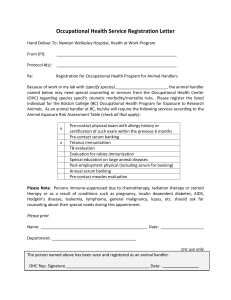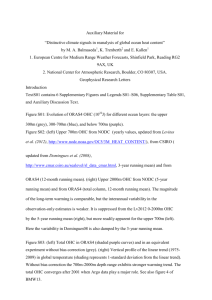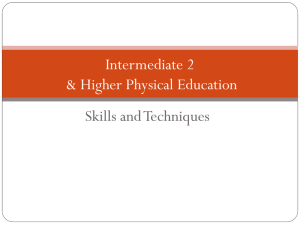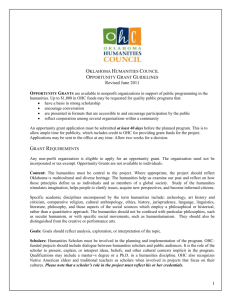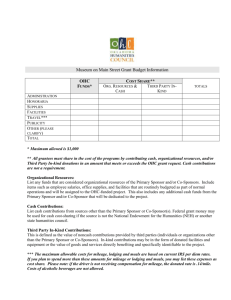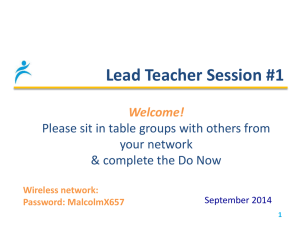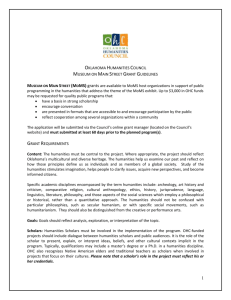Explain why you used the two methods to identify factors impacting
advertisement
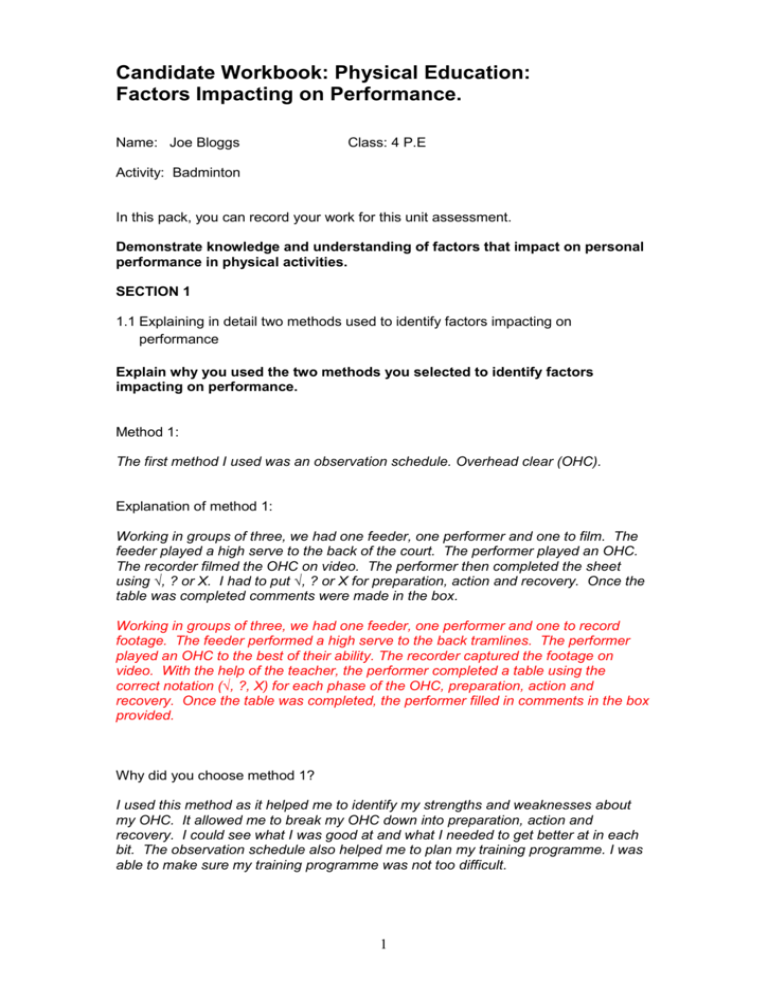
Candidate Workbook: Physical Education: Factors Impacting on Performance. Name: Joe Bloggs Class: 4 P.E Activity: Badminton In this pack, you can record your work for this unit assessment. Demonstrate knowledge and understanding of factors that impact on personal performance in physical activities. SECTION 1 1.1 Explaining in detail two methods used to identify factors impacting on performance Explain why you used the two methods you selected to identify factors impacting on performance. Method 1: The first method I used was an observation schedule. Overhead clear (OHC). Explanation of method 1: Working in groups of three, we had one feeder, one performer and one to film. The feeder played a high serve to the back of the court. The performer played an OHC. The recorder filmed the OHC on video. The performer then completed the sheet using √, ? or X. I had to put √, ? or X for preparation, action and recovery. Once the table was completed comments were made in the box. Working in groups of three, we had one feeder, one performer and one to record footage. The feeder performed a high serve to the back tramlines. The performer played an OHC to the best of their ability. The recorder captured the footage on video. With the help of the teacher, the performer completed a table using the correct notation (√, ?, X) for each phase of the OHC, preparation, action and recovery. Once the table was completed, the performer filled in comments in the box provided. Why did you choose method 1? I used this method as it helped me to identify my strengths and weaknesses about my OHC. It allowed me to break my OHC down into preparation, action and recovery. I could see what I was good at and what I needed to get better at in each bit. The observation schedule also helped me to plan my training programme. I was able to make sure my training programme was not too difficult. 1 Method 2: The second method I used was a scatter diagram. Overhead clear (OHC). Explanation of method 2: Working in groups of three I played a match against a partner and another pupil recorded data. The observer / recorder wrote down on the sheet where my OHC shots would have landed using an (X). I played a game to 15 points against somebody who was the same ability as me. Working in groups of three, we had an opponent and myself playing a match and another pupil to record data. The observer / recorder noted down on a diagram of a badminton court where my shots were played during a game of badminton. My observer / recorder used an (X) to pinpoint exactly where my OHC shots would have landed during the game. It was important I played an opponent of similar ability to myself and we played a game to 15 points. Why did you choose method 2? I used this method as it was a simple way of collecting information on my OHC. I can look at my scatter diagram and see where all the Xs are. I get a good idea of whether my OHC is good or not. The scatter diagram allows me to see if I have got better once I have done my training programme. I can compare before and after. SECTION 2 1.2 Explain in detail the impact of one positive and one negative factor on performance Choose two factors from Physical, Social, Mental and Emotional. State and explain the impact of this factor on your performance. Give examples to reinforce your answer. Explain in detail the impact of one positive and one negative factor on performance. What is the positive factor you have chosen? Mental - Concentration What is the impact on performance of this factor? Mental factors can effect how well I play. I can perform better because I am making better decisions. I was able concentrate during a longer match on the shots I was playing. With good concentration I was able to ignore any noises or other things that might have put me off. Mental factors affect performance and leads to less errors being made. This could mean that performance levels increase because there are more effective decisions being made. For example, I was able to concentrate and listen to any feedback my teacher gave me on my performance. I also found I was able to remain focussed during a longer match and concentrate on the task in hand. With good concentration I had the ability to shut out any external factors which could affect my performance, i.e. – noises, opponent reactions, etc. 2 What is the negative factor you have chosen? Physical - Cardio-respiratory endurance What is the impact on performance of this factor? With poor levels of cardio-respiratory endurance I found that I was becoming very tired towards the end of longer games. For example, towards the end of games I became out of breath and found it hard to keep moving around the court. I found that I was slow in getting to my opponents returns. My shots became rushed and allowed my opponent to punish my poor shots. Develop personal performance in physical activities. SECTION 3 2.1 Describe strengths and areas for development in your performance. From your performance, describe one strength and two areas for development in a performance. My strength is: In badminton my strength is my high service. I transfer my weight during my service which gives me more power. I can get height and distance with my service. This puts my opponent to the back where it is hard to play a good shot. I win a lot of points because I have a good high serve. In badminton, a strength within my performance is my high service. I am able to transfer my weight at the point of contact which allows me to get power in my service. As a result I can get height and distance on my service. This forces my opponent to the back tramline and puts them under pressure immediately. Having a good service usually allows me to get the upper hand in rallies. Development area 1: My OHC could be better. As I don’t get side-on my OHC lacks power and usually goes to middle of the court. This means I am not pushing my opponent to the back. I am not putting my opponent under pressure. My poor distance in my OHC allows my opponent to play a smash and win the point. My OHC requires further development. As a result of not getting side-on my OHC lacks power and tends to land mid to ¾ court more often than not. This means I am not pushing my opponent to the corners of the court which means they have an easier return shot to play. At times my poor distance in my OHC allows my opponent to play a smash and win the point. Development area 2: My smash could also be better. I don’t get side on as I get ready to hit a smash. This means I don’t really transfer my weight and my smash has no power. During the middle part of my smash my point of contact is wrong as I hit my smash flat which means it looks more like an OHC. I don’t win many points with my smash. 3 4 SECTION 4 1.3 Explain two approaches to develop performance Explain two approaches/ types of practise to develop performance. Approach/type of practice 1: Shadow drills Advantages: Shadow drills could be used to develop performance. Shadow drills are good as they let me learn the basic movements. The performer can practice without having to think about the shuttle. It can be slowed right down to give me time to think about what I am doing. I can get a feel for the correct movements. An approach that can be used to develop physical factors are shadow drills. The advantage to using this approach is that it can be used during the preparation stage of learning where the performer is trying to learn the basic movements. The performer can get used to the movement without having to think about the shuttle or their opponent. The movement can be slowed right down to give the performer time to think it through. Disadvantages: The main disadvantage of shadow drills is that they are not game related. You also don’t get a feel for hitting the shuttle. Shadow drills can also be a bit boring and you can lose interest very quickly. When this happens I find that I don’t really get better. The main disadvantage of using shadow drills is that the practice situation is very unlike a real game. The performer would not be able to experience the feel of hitting the shuttle. These practices are limited in terms of developing the skill in more game like situations. Shadow drills are limiting in terms of allowing variety to be brought into the practice. This can lead to boredom and decrease the quality of the practice. Approach/type of practice 2: Feeder drills Advantages: Feeder drills can be used in the preparation and practice stages of learning. My partner is able to vary the feeds which is helpful. As I get better my partner can hit the shuttle further back which puts me under more pressure. I could hit ten shots and then have a rest which means I don’t get tired or bored. Disadvantages: A disadvantage of feeder drills is that they are not really related to a real game. In a feeder drill I know exactly where my partner is going to hit the shuttle. This is not true in a match. It is okay to improve my technique of my OHC, but can I do it for real in a match when I am under pressure. 5 SECTION 5 2.2 Prepare and implement a personal development plan with identifiable targets Prepare a personal development plan with identifiable targets you think will help you improve your performance in the area you have chosen. You will be observed implementing part of the development plan by the assessor. What skill/technique do you want to develop? Overhead Clear. (OHC) My targets are: To get consistently side on during the preparation for the OHC. To increase the percentage of my OHC’s which reach the tramlines. Personal development plan. Session 1 Skill OHC Type of practise Shadow drills. Focus Reps / rest Start from a central base. 5 sets of 12 reps. Move to where shuttle will be played – get side on. 2 minutes rest between each set. 6 sets of 10 reps. 2 OHC Feeder drills. Move to where shuttle will be played – get side on. Recover to central base between each rep. Shift weight onto back foot. 2 minutes rest between each set. 6 sets of 12 reps. 3 OHC OHC Feeder / target drill Shift weight onto back foot. Gymnastic mat placed in back corner as a target to hit. Action resembles throwing action. Repetition drill 2 minutes rest between each set. Action resembles throwing action. 4 ( Lift – Clear – Drop ) Recover to central base between each rep. Contact shuttle above racket shoulder with open face. 6 Aim to complete the set of L-C-D five times through. 60 seconds rest between each set. SECTION 6 2.3 Select and apply two approaches to impact positively on a performance. APPROACH 1: How will you use this approach during your development session? Type of PRACTICE: Shadow drills. I used shadow drills to improve my OHC. In a shadow drill I had to shadow the correct movement of the OHC. I would start from the middle of the court and go through the movements of the OHC without actually hitting a shuttle and then return to the middle. I did this twelve times in a row and then took two minutes rest. I completed five sets of twelve. I used shadow drills within my training to improve my OHC. Shadow drills, as the name suggests, involved me shadowing the correct movement of the OHC. I would start from a central base and go through the movements of the OHC without actually hitting a shuttle and then return to my base. I did this twelve times in a row and then took two minutes rest. I completed five sets of twelve repetitions. Whilst performing the OHC I would pay particular attention to any parts ( P.A.R ) that were identified as a weakness. APPROACH 2: How will you use this approach during your development sessions? Type of PRACTICE: Feeder drills I used feeder drills to improve my OHC. In a feeder drills a partner would feed the shuttle allowing me to practice my OHC. The feeder would high serve to the back of the court. Starting from the middle I would perform an OHC and then return to the middle. I did this ten times in a row and then took two minutes rest. I did six sets of ten. 7 SECTION 7 2.4 Complete evidence of monitoring and recording a minimum of three performance development sessions. You must record and monitor your progress during your performance development sessions. Training diary. Session / Date Progress made Problems encountered Changes to be made I was getting my body side on more often. I got tired during the practice I will do less reps. DD/MM/YY Session 1 Practice Shadow Drills DD/MM/YY Session 2 Shadow practice was boring I was getting my body into the right position to hit the shuttle. Practice Feeder Drills Use a practice that needs a shuttle When the shuttle was right at the back of the court I really struggled. Get my partner to hit the shuttle higher – I get more time. I found it difficult to get my weight on my back foot. Tell my partner to not feed it so far back. I had too much to think about and I was getting confused. Do this session again to give me more time to get better. DD/MM/YY Session 3 I am now getting my weight on my back foot much more often. Practice Feeder Drills 8 Evaluate the performance development process. SECTION 8 3.1 Record and submit evidence of seeking two examples of feedback from others which evaluate the candidate’s performance development plan You must seek FEEDBACK about your performance. If you asked for verbal feedback, please record the question asked and the answer received. You could ask a classmate, your assessor or a coach. Name and describe the method of feedback you used. Example 1. Name of feedback: Visual Feedback Description of feedback My classmate videoed a half court game against an opponent of the same level as me. The video was taken from a side on view of the court. The video lasted ten minutes. Explain why you used this method of feedback. I used this method to help me improve because this meant I could see myself playing the overhead clear and see what I was doing right and what my faults were. Having a picture in my head of what I was still doing wrong helped me improve better. I also got to see my shot lots of times. Recording my performance gave me really good external feedback. I was able to pause, rewind and use slow motion to see what my strengths and weaknesses were. This made my feedback more accurate. This feedback was also permanent and can be used at a later date. Ten minutes of video helped me see my overhead clear a number of times in lots of different situations. Example 2. Name of feedback: Written Feedback Description of feedback: My partner watched me practice and filled out a PAR sheet on how well I played my overhead clear. My partner put a √,? or X in the box. Once the sheet was completed comments were made in the box at the bottom. During a feeder practice my partner filled out my PAR observation sheet. My partner watched me play 15 overhead clears and marked down a √ if I did the part well or an X if I did not play it well. All parts of the overhead clear were split into three stages, preparation, action and recovery. All these points are listed down the left hand side of the schedule. Explain why you used this method of Feedback This feedback gave me good and reliable information on my shot which meant I could compare my tick sheets of before and during my training programme to see if my technique was getting better. This feedback broke my performance down into preparation, action and recovery making it easier to pick out my strengths and weaknesses. It meant the feedback I got was accurate and reliable. This also gave me a permanent record of my performance so I could do this again at a later date to compare information. 9 Section 8 continued What questions did you ask? Example. How many times did I perform the ‘skill’ in the game? ______________________________________________________________ How many successful shots did I play? ______________________________________________________________ What am I doing well when I perform my ‘skill’? When playing my overhead clear I don’t make many mistakes and don’t give away easy points to my partner by keeping the shuttle in the court. I get side on to the shuttle and transfer my weight sometimes. My strengths are in the preparation phase where I get behind the shuttle and get my arm back to hit the shuttle. In the recovery phase my racket arm always follows through in the direction I want the shuttle to go. I always return to my base in the middle of the court. I am quite consistent and don’t often make mistakes. What do I need to improve on when performing my ‘skill’? I need to try and straighten my arm more during the middle part of the OHC. I must try and hit the shuttle at its highest point. I need to get more power in my OHC so it goes further to the back of the court. I found mainly the action phase the hardest to do. I had difficulty managing to straighten my arm to hit the shuttle which meant that I did not achieve the height and depth I required to pull my opponent away from base. I also found it hard to transfer my weight from the back foot to the front foot. This meant that I didn’t get the power and strength required to make a good shot. Not transferring my weight made my recovery phase slow when trying to get the next shot. 10 SECTION 9 3.2 Provide evidence of the evaluation of the effectiveness of your development plan in supporting your performance development. Now you have carried out your performance development plan make two comments relating to how effective your training was. How well did your plan work? Did it go as well as you thought it might do? You can compare your initial data and final data from the methods you chose. My plan was good in helping me improve my OHC. I include different drills which kept me interested and motivated. I changed the drills to make them harder as I got better. I was challenged to work to my target. My second scatter diagram showed that my OHCs were landing nearer the back of the court. My plan helped me to get better at the OHC. My observation schedule showed that some of the bits I was poor at before, I was now better at. I get side on more often. The shadow drills were good as they helped me slow it down and get it right. I still have some Xs in my sheet which means I have still things to get better at. 11 3.3 Provide evidence of evaluating progress based on all information gathered. Based all the information you gathered including your feedback, training diary, data collection sheets, videos etc. Can you explain any changes in your performance? You can compare your performance before your development plan to your performance after you have carried it out. Initial performance showed; My OHC could be better. As I don’t get side-on my OHC usually goes to middle of the court. This means I am not pushing my opponent to the back. I am not transferring my weight which means I am not putting my opponent under pressure. My poor OHC means my opponent can attack more. My end of programme performance showed My overhead clear is now much better because I don’t make as many mistakes and it goes much further to the back. By getting side on and transferring my weight I can now hit the shuttle to the back. I am winning more points. After completing my improvement programme my overhead clear was far more powerful with less unforced errors made. I was now transferring my weight which gave my shot more distance which put my opponent under pressure at the back of the court. Hitting the shuttle with a straighter arm in the action phase also made my overhead clear more powerful with better timing. My opponent found this difficult to return and now I have the ability to end a rally with a smash from my opponent’s shots to the middle of the court. My opponent was also using up more energy having to run to the back of the court. 12 SECTION 10 3.4 Identifying and explaining at least two future development needs Choose two other areas of your performance which you could develop in the future. You can answer by including further development of your specific weakness and or other factors that affect your performance from the: physical, mental, social & emotional factors. Development need 1: Physical - Smash. Explain why your weakness would require further development and the impact this has on your performance. You can respond by including other factors that affect your performance from physical, mental, emotional, and social. Another part of my performance I would improve would be my smash. I don’t really transfer my weight and my smash has no power. During the middle part of my smash I bend my arm when I hit it which means it looks more like an OHC. I don’t win many points with my smash. Development need 2 Emotional - Sportsmanship Explain why your weakness would require further development and the impact this has on your performance. You can respond by including other factors that affect your performance from physical, mental, emotional, and social. I get angry and really annoyed when I lose. I don’t like it when I have to move down the ladder. I often lose my temper and sometimes throw my racket. I need to learn how to control my temper. I must show a good attitude no matter who I am playing. I must always shake hands. 13 14
